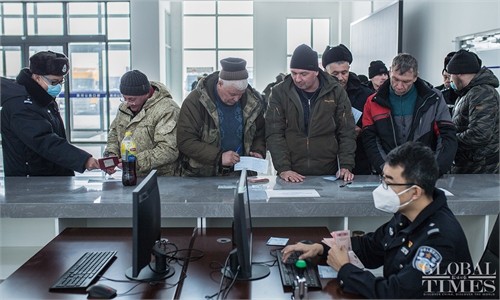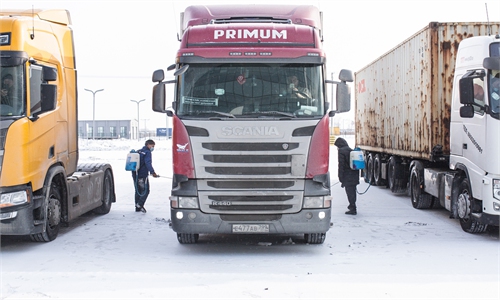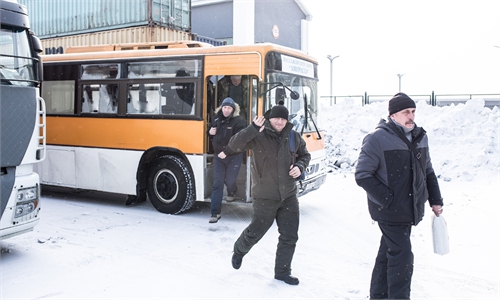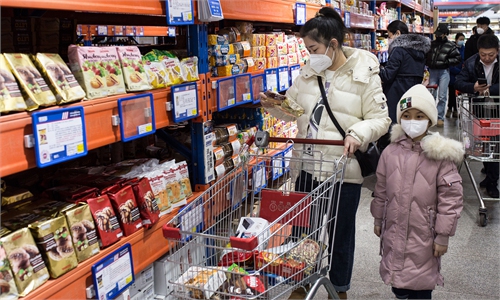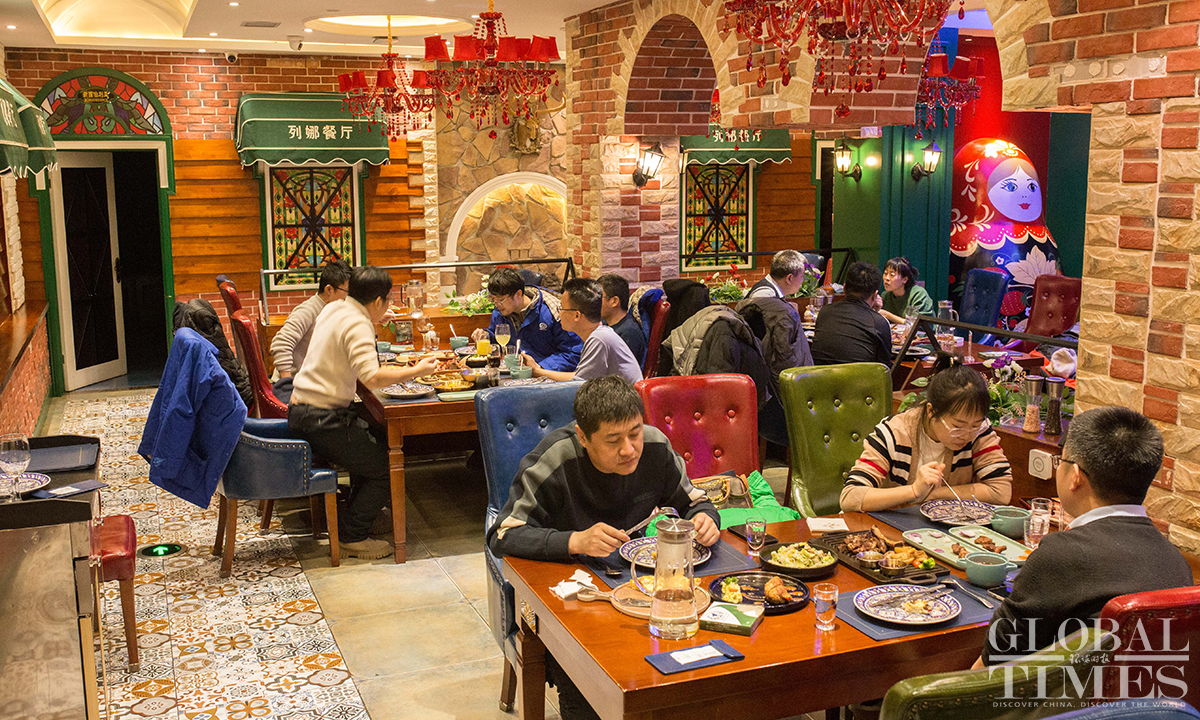
Locals and visitors in Heihe, Northeast China's Heilongjiang Province enjoy shopping and delicious food on February 11, 2023 as the border city regains vitality after China downgraded its COVID-19 management in December 2022. Photos: Shan Jie/GT
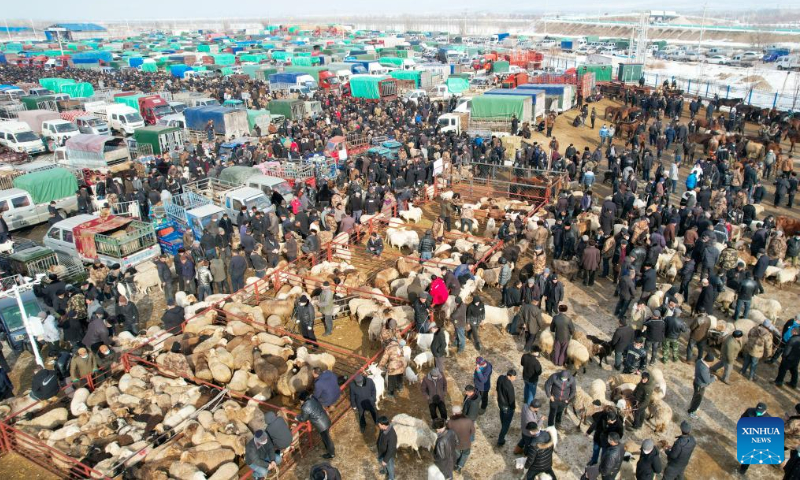
This aerial photo taken on Feb. 1, 2023 shows people selecting cattle and sheep at an agricultural products market in Yining County, northwest China's Xinjiang Uygur Autonomous Region. People gathered here to trade various goods, including live cattle, sheep and horses. Photo: Xinhua
When China's border cities were heavily impacted due to the country's COVID-19 control measures, they had to take the hardest task in helping the country to keep the coronavirus at bay. Now that the borders are reopened, a sense of revival and the quickly returned hustle and bustle have showered these border cities. These cities are also resuming trade with neighboring countries, greeting an influx of tourists, eyeing foreign goods entering their markets and they are excited to resume their traditional winter sports, all without the fear of the coronavirus.GT staff reporters visited a number of border cities, including Heihe and Manzhouli, which connects China and Russia; Bortala Mongolian Autonomous Prefecture in Northwest China's Xinjiang Uygur Autonomous Region; and witnessed the increased activity after borders were fully reopened.
Such quick return of normalcy can also be seen as a mirror of China's rapid bounce back from the COVID-19 shadow. The resilience of its economy, the speed of recovery and the vast market will help the nation to achieve robust growth in the months and years to come.
Normalcy returned, economy revived
The fully loaded flight from Harbin, capital of Northeast China's Heilongjiang Province, already illustrated the revival of Heihe, a border city between China and Russia with a population of about 1.3 million. Heihe is about 571 kilometers from Harbin.
New construction trucks parked along both sides of the roads in the city for about three kilometers further demonstrated the fact that the border city Heihe, an important channel for imports and exports as well as a gateway through which Chinese and Russian tourists go to each other's countries, is stepping out of the shadow of the COVID-19 epidemic and returning to old busy days.
The Heihe highway port officially resumed two-way customs clearances for goods exchanges on Friday. As of 2 pm that day, the port had conducted clearances for more than 100 vehicles and 1,800 tons of goods, China Central Television reported.
A bus carrying 19 Russian drivers arrived at the arrival hall of the Heihe-Blagoveshchensk cross-border highway bridge on Friday morning. The drivers excitedly waved their hands to the Global Times reporters and greeted the staff at the inspection station at the port when handling procedures at the arrival hall.
Trucks loaded with goods such as soybean oil from Russia continually passed through the guard points of the Heihe port via the Heihe-Blagoveshchensk cross-border highway bridge and parked in front of the arrival hall while waiting to go through the procedures.
I am so excited that the toughest days of the epidemic have finally passed and we can meet foreign arrivals face to face again, Wu Chundong, a deputy captain on duty at the Heihe highway port inspection station, told the Global Times.
Wu said he can still remember the days when staff at the inspection station had to wear protective clothing and goggles all the year round during work in the past several years. "The protective clothing is hot and stuffy in summer but cold in winter. And we could only watch the foreign drivers faraway through the goggles as we conducted non-contact procedure during the epidemic."
It is the persistence of all our staff that has guaranteed the function of the Heihe port and earned today's success, Wu said emotionally.
Chinese border cities heavily impacted due to the country's COVID-19 control measures as borders were closed for the past three years to keep the coronavirus at bay. From January 8, 2023, China adjusted and optimized its control and prevention measures. On the same day, customs clearance at multiple ports officially resumed, and cross-border tourism, which had been suspended, has been reopened.
This has injected much-needed vitality into the border cities.
Du Xiaorui, , told the Global Times that the downgrade of management of COVID-19 has smoothened the import and export of goods. Also on January 8, China scraped nucleic acid test for imported goods.
"During the epidemic period, it took us one hour to check one container, sometimes two hours. After the COVID-19 test requirements were scrapped, now it took us only around 10 minutes to check the containers," said Du, an inspector at the Manzhouli port in North China's Inner Mongolia Autonomous Region.
Normal life returns
Dozens of tourists lined up to pose pictures in front of an iced sculpture within a scenic spot at Sayram Lake, the largest and highest alpine lake in Bortala Mongolian Autonomous Prefecture, Northwest China's Xinjiang Uygur Autonomous Region .
"I traveled here with my mom. This is my first long-haul trip in the past three years. Besides the Sayram Lake, I also went to Altay for skiing," said Chen Yizi, a high school student from Shanghai.
Though the tourism market in Xinjiang is still at its off season, about two or three thousand tourists visited the Sayram Lake every day, most of whom came by self-driving. Sayram Lake, dubbed the "last tear of the Atlantic," is a must-to-go place for self-driving tours in Xinjiang.
Back during the Spring Festival holidays from January 22 to last week, the first such holidays after the country downgraded COVID-19 management, the daily visitors to the lake surpassed 30,000, even more than during the Spring Festival holidays prior to the epidemic, Jiang Hua, deputy director of the management committee of Sayram Lake, told the Global Times.
Hotel rooms for tourists at the lake will be increased to 5,000 this year. Other than that, hotels in nearby cities would be fully booked in high season, the Global Times learned.
Zhang Rui, an ice hockey coach in Manzhouli, where such winter sports are popular, told the Global Times that he is happy that the hockey training is resumed this winter. "The COVID-19 outbreak always struck Manzhouli in winter, which is the high season for us to train, as there is snow. Sometimes the kids recorded video of them playing ice hockey and upload on chat app so I can correct their movement," said Zhang.
"Now that the COVID-19 controls are scrapped, I will increase the kids' training in the near future, so they can improve fast, and carry out Manzhouli's old tradition," Zhang laughed.
